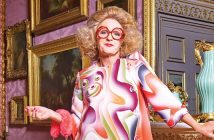If you’re anywhere near St James’s in central London in the coming weeks and you need a quick lesson in post-war British art, you could get an instant fix at two galleries currently running a joint exhibition of the early work – well, early-ish – of Alan Davie. The period in question spans 1948-1969 and I say early-ish because, at 91, Davie even had a period or two before that.
The result of a two-year collecting mania by Alan Wheatley (proprietor of one of the galleries in question), this extensive body of work captures some of the very best of what Davie is known for. The period is specific because it falls between styles, and reflects social as well as creative influences – some of which, incidentally, leap out at you – Pollock, Chagal, Miro, are all in evidence. “There’s something for everyone in every sense,” says Wheatley. Including (albeit not by the artist) sculptures collected by Davie from Africa.
A man of diverse interests, from oriental mysticism to underwater swimming, even being an accomplished musician, Davie’s works are bountiful, bursting with vibrancy, colour and symbolism. Often painting on huge canvases – and sometimes boards simply nailed together – these works surround you (literally, in fact, there’s barely an inch of wall space left uncovered at the galleries) and swallow you up. Hearing about his musical background, this is the figurative equivalent of being in a smoky basement in 1950s Paris with each canvas a different improvisation from the band on the stage. These paintings practically play to you.
Born in 1920 in Grangemouth, Scotland, the self-taught Davie was playing tenor saxophone for the Tommy Sampson orchestra when he had his first solo show in 1946 in Grant’s bookshop in Edinburgh. Touring Europe in a jazz band clearly had its influences, too. While his foundations may have been laid in Scottish painting, French abstract and exposure to the work of his contemporaries in Venice, including Pollock and Paul Klee, began to rub off. Arguably, however, at this time it was the ‘art’ of Zen mysticism that took hold and this philosophical approach to his art accounts for the title of this exhibition, To Uncover the Hidden Unknown. It’s cerebral not only in style but also in method; spontaneity and the subconscious dictates what gets put on the canvas, like painting automatically. And, funnily enough, the Pollock influence extends beyond simply the design but, like Pollock, Davie often paints with the canvas on the floor.
At 91, Davie still paints, draws and plays. If scale were to ever define Davie’s works, I understand he’s currently working on a 40 metre watercolour, his self-proclaimed great masterpiece, and determined, he says, to finish it before he dies.
Artist and fellow Scot, Douglas Hall, penning an essay for the accompanying exhibition book, writes “There is so much more to be said about Alan Davie as man, philosopher, musician, even mystic, that cannot be touched on here…But above all he speaks through his paintings, and it would be hard to find a better occasion to listen to them than this exhibition.”
If the interest in this exhibition to date is anything to go by – not to mention the works currently held in countless private collections and galleries around the world – it’s testament to Davie’s role in the pantheon of 20th century British art. This, however, is a fantastic chance to see such an important range of work of such an important artist on such a wonderfully personal and intimate stage. I can’t imagine there’d be many more such opportunities…
Alan Davie: To Uncover the Hidden Unknown runs at Alan Wheatley Art and Gallery 8 on Duke Street, St James’s, until Sunday 26th June. The exhibition then continues at Alan Wheatley Art until Friday 22nd July.




